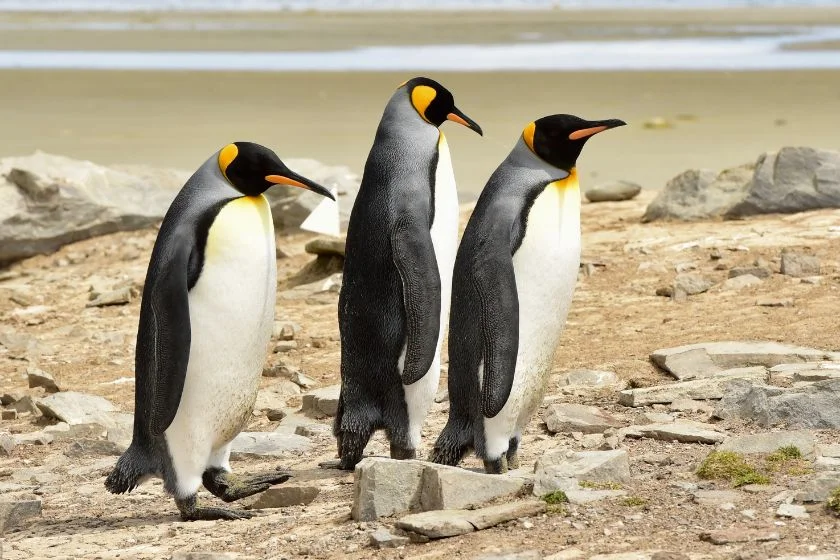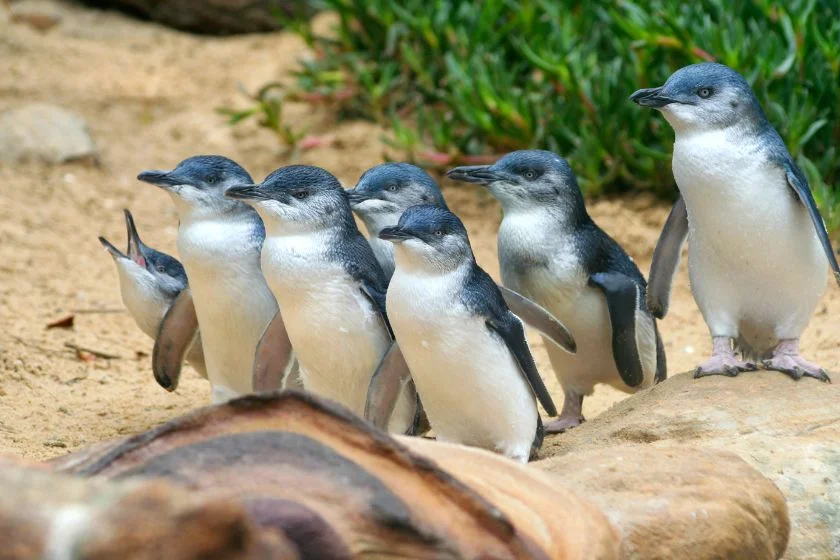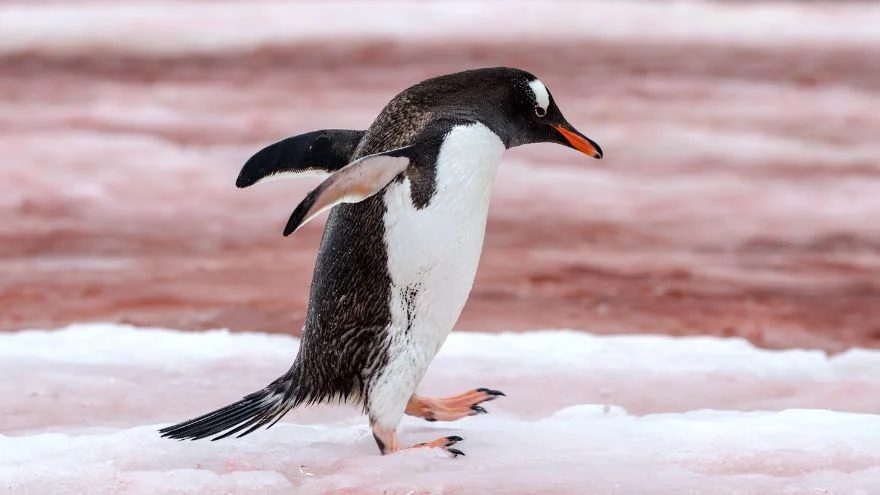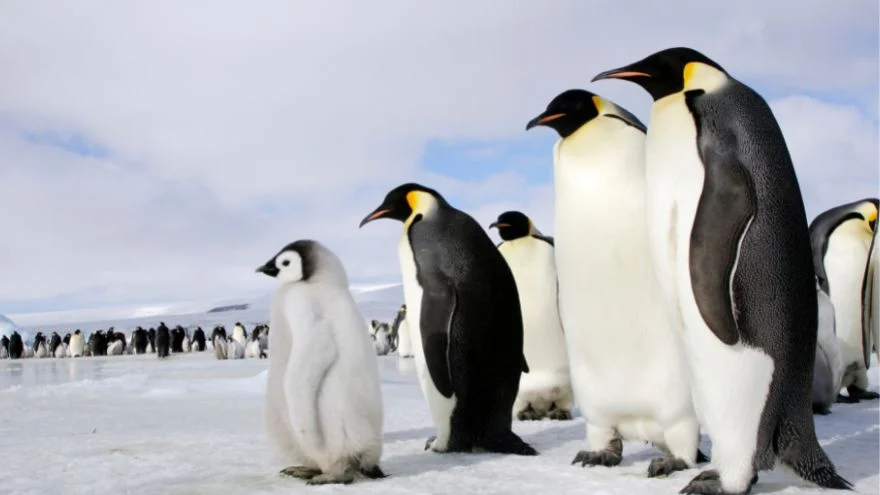Penguins are members of the Spheniscidae family. They are unique, flightless birds that are associated with cold regions.
Though they can live in some other areas, there’s a link between these birds and the snow.
They have a lot of fans because of their peculiar (read: cute) looks, but there’s a lot more to this bird than being an inspiration for stuffed toys.
There are more than 15 species in existence today. They all have similar features, ways of living, and behaviors.
For instance, these birds are aquatic and can stay on both land and water.
These are traits that would make up our profile on the waddling bird. We’ll cover as much information as you need.
Scientific Classification

| Kingdom | Animalia |
| Phylum | Chordata |
| Class | Aves |
| Order | Sphenisciformes |
| Family | Spheniscidae |
| Binomial Name | Aptenodytes Forsteri (one species) |
Characteristics
| Height | 10 to 45 inches |
| Weight | 2.2 to 75 pounds |
| Wingspan | 60 to 130 cm |
| Venom/Poison | No |
| Skin Type | Feathers |
| Habitat | Oceans, coasts |
| Range | Antarctica, Australia, South Africa, Chile |
| Diet | Carnivore (Main prey: Rishes, small marine animals) |
| Lifespan | 6 to 26 years |
| Incubation Period | 65 to 75 days |
| Conservation status | Near Threatened |
Interesting Facts About Penguins
1. Penguins can adapt to both water and land (but can’t fly)

Penguins have a skill many birds (and humans, in fact) don’t have.
They can alternate between an aquatic and terrestrial environment, spending a good amount of time in both places.
They can’t fly, and because they live on islands, they’ve learned how to survive in water.
However, these birds aren’t like fishes. They have no gills and can’t breathe underwater.
They survive only because they can hold their breath for a long period, some species going for more than 20 minutes.
They also have a respiratory system that can keep them going with a low amount of oxygen.
2. Their black and white tuxedo look serves as camouflage
Penguins are admired for their skin color, which combines black with white (and sometimes a streak of yellow) to give them the tuxedo look everyone loves to see.
But the coat isn’t just to make a fashion statement, it is also a camouflage.
This camouflage is called countershading, and it protects them from predators, especially when they are swimming.
The black color on their back keeps them hidden from predators as it enables them to blend with the deep waters.
3. There were once penguins as big as humans
As creepy as that may sound, it is true. In prehistoric times, a genus known scientifically as the Anthropornis nordenskjoeldi was a group of giant penguins that grow as tall as humans.
They lived millions of years back, weighed 200 pounds with an impressive height of 5ft 11 inches. Some were even known to get up to 6ft!
The Anthropornis has since gone extinct, which is likely tied to the coming of seals and whales with large teeth.
4. The blue penguin and the emperor penguin are the smallest and largest species

The smallest living species is the blue penguin, found as the only species in the Eudyptula genus.
It is also known as the little blue penguin, the little penguin, or the fairy penguin.
Its height falls between 12 and 13 inches, with a weight that’s up to 3 pounds.

The largest living species is the Emperor, growing up to 45 inches with a weight that’s up to 88 pounds. It can be found only in Antarctica,
5. Penguins are monogamous
We’ll discuss the mating process in a later section, but for now, we can say that these birds are good examples of monogamy.
They tend to stick to one life partner for a long while, and their courtship process is sometimes described as romantic.
However, this doesn’t mean there are no exceptions. The hook-up culture is a reality, and they may copulate with different partners even while having a mate.
This often leads to conflicts and complications, quite similar to the drama seen in soap operas.
General Description
The recognizable traits of the penguin go from its color to its waddling.
These birds look like limping individuals in a tuxedo when they’re on the move.
They can’t fly because their short wings can’t lift the big body, but in place of that, they are excellent swimmers.
The skin doesn’t look like it has feathers, but in reality, it does. These feathers are important as they play key roles.
They help penguins while swimming and also protect them from harsh temperatures.
Though similar in many ways, each species have its unique qualities which may be tied to where they live.
Emperors have a fat reserve and more feathers, blue penguins have blue tinted feathers in place of black, rockhoppers have feathers on their heads, and capes have pink patches above their eyes.
There are also special ones known as isabelline penguins. They’re sometimes mistaken for albinos, but they aren’t.
Isabellines are born with light brown feathers instead of black. Many people find them attractive, but sadly their life expectancy is shorter than other penguins because they find it harder to camouflage.
Penguin Behavior
Penguins are social animals, and they live in colonies. They do have solitary activities like looking for food, but in species like the emperor, hunting is still done in groups.
The best time they come to colonies is during the breeding season, and these colonies are called rookeries.
Penguins groom the feathers with their bills. This is done frequently so they can remain both waterproof and insulated.
The grooming is done in water where they twist while distributing the feathers.
We also have gait. These birds walk on both feet like humans, but they waddle rather than move straight.
Some may also prefer jumping, or they slide down in a snowy environment. This is called tobogganing.
Another unique behavior is the sleeping habit. They tend to sleep standing, and rather than a long stretch of slumber, they sleep in short bursts. Those in cold regions huddle together while resting to preserve heat.
Penguins Distribution and Habitat
Penguins aren’t found only in Antarctica, contrary to some opinions. They live majorly in the Southern Hemisphere, and only a few can be found close to the equator and the Northern Hemisphere.
Their range isn’t worldwide, but one can find them in zoos in countries they aren’t supposed to be in.
Their range includes:
- Angola
- Antarctica
- South Africa
- Namibia
- Chile
- New Zealand
The species have different locations, but altogether there are habitats you can expect to see them in. The two common habitats are islands and coasts.
Penguin Diet

Penguins are carnivores, feeding mainly on fishes and small marine animals. This is one reason they stay close to the waters.
Each species have its preferences, which is a good thing as it reduces competition amongst those that may live in the same environment.
Their common diet includes crustaceans, squids, and various kinds of fish. They feed at sea and use their eyes to hunt, more than any other senses. They sometimes hunt at night, though no one is quite sure how they manage given their reliance on sight.
Other tools they use to hunt include their wings and bills. The wings help them swim through the waters, and the bills come in handy when swallowing fish.
Then there are the tongue and jaws that stop slippery prey from slipping away.
Some species move a long distance in search of food. This can get to over 1,400 km for the emperor penguins and nearly 900 km for Adélies.
They also swallow stones after a meal, possibly to help with digestion.
Reproduction and Mating Process
As we stated in a previous section, penguins are (mostly) monogamous. Some stay monogamous only for the breeding season, others remain life partners, similar to a marriage.
Cases of promiscuity are common, but compared to many other animals these birds set a better example of a long-term partnership.
Monogamy is an advantage as it helps them focus on reproducing and less on trying to find a suitable mate.
They have a courtship ritual that they use to seek out a compatible partner.
These rituals differ from one species to the other, but it usually involves making a call and some gestures.
Usually, the male makes the first move. Some show romantic gestures using pebbles to court the female.
When courtship is successful, these folks then begin reproducing. While mating, the males climb on the female’s back while she lies down. Their cloaca meets, and sperm gets transferred.
Both partners are involved in taking care of the eggs. The females lay the egg while they both incubate it.
Some species build nests where the incubation takes place, others carry the egg on their feet.
The Emperor is an exception to the rule of shared incubation. Only the male takes care of the egg for two months.
Many species lay 2 eggs in a season, but bigger birds lay only one. These eggs tend to be smaller than that of other birds.
Some females have the crazy habit of trying to steal another mother’s egg when they lose theirs.
They hardly succeed because other females in the colony will intervene.
The breeding season is usually between October through February, though there are some exceptions as some breed in winter.
They often breed in large colonies, and only a few species like the Fiordland don’t uphold this tradition.
Predators and Threats
Penguins face predatory threats from stronger predators that share the same habitats as them.
These include sharks, leopard seals, fur seals, sea lions, and killer whales. A penguin is more endangered when at sea as many of the predators are aquatic.
This is where its skin helps. On land, they have little predators, though some birds may steal the eggs.
Penguins are more curious than scared of people. However, you shouldn’t get close to them or their nests.
They can attack if they feel threatened. Humans are not considered much of a threat, but we do cause habitat loss. Fishing also reduces their numbers.
One of their biggest threat is climate change, and it has reduced their numbers. They have also suffered from other factors like pollution and habitat loss.
Male vs Female

The differences between a male and female are not significant, and a casual observer may find it difficult to pick out a male from a group. That said, they aren’t the same.
Males are usually bigger than females, though not by much. The males also have longer beaks. The more attractive males tend to be burly.
The mating behavior is where the biggest distinction lies, with the males initiating the courtship process.
The males fix the nest, find pebbles and do what they can to attract the females.
Frequently Asked Questions
What is the penguin population?
Generally, penguins are considered near threatened. Some species have more population than others. It is hard to determine the exact number of all penguins, and you can only know for each species.
What is a penguin baby called?
A penguin baby is often called a chick or a nestling. In a group, they are termed “crèche”. The sign of growth is when the chick gets waterproof feathers. Until then, it depends on its parents.
Are penguins dangerous?
Penguins are not considered dangerous, and if you keep your distance you wouldn’t have any problems. They aren’t scared of humans, but if you get too close they can attack, leaving you with slaps and kicks.
Can I have a penguin as a pet?
Penguins are cute birds, and most people would consider it exotic to have one as a pet. However, this is neither advisable nor legal. Penguins are best left in their natural habitat, or at zoos.
Why do penguins waddle?
Waddling may not seem like the best method to move, especially as it seems uncomfortable from a human’s point of view. However, it is the fastest way for them to move with their short legs.
Final Thoughts
Penguins remain one of the most admired birds, and despite their inability to fly, they have many more abilities that help them survive in whatever habitat it is in.
They can’t be kept as pets or approached without caution, but they aren’t deadly beasts. The tuxedo animals are a delight to watch.




